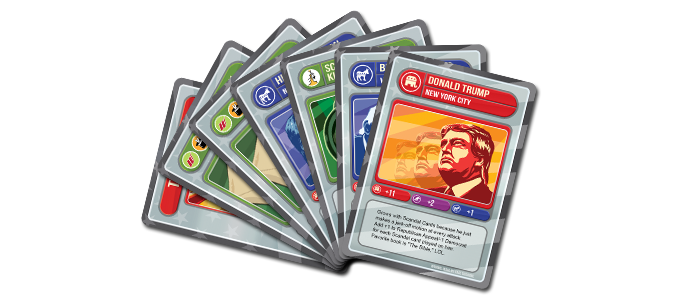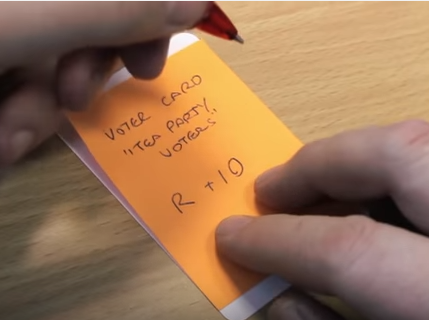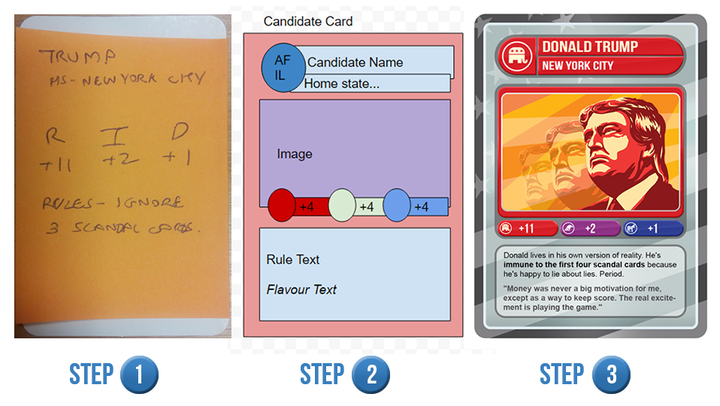Glance at any news coverage and you'll see the US presidential elections dominating it. It's on a lot of people's minds as it determines who will (arguably) be the most powerful person in the world.
So, drawing from this ongoing story and an enduring interest in politics, I've spend a fair chunk of time of late working on a card game based on the US political system. You can check it out here.
Quick confession: I'm not American, I'm British, so I'm very much an observer in the ongoing political games across the pond. So why would a games designer in Bristol be working on a game about the US political system as opposed to, say, a game about zombies or aliens?
To some it might seem like an odd idea, but the US political system and the characters who inhabit it are fascinating (and a bit scary) and the whole thing is great fodder for games design. We're also lucky enough to have been working with US based political commentator Rebecca Schoenkopf, who, along with the rest of her team, really knows her stuff. So that helps ensure that I'm getting the nuance (and comedy) of the game right from the off.

Overall though, the political process translates into a fascinating game, because politics shares so much with games. Each is a complex system that is designed to distil a complex set of interactions into a flowing and understandable system. You also need to build in hooks for the player (or voters) to join in.
I feel it really helps to show how you can apply thoughts about a system into a game design, so I thought it might be interesting to use the work on this current game to show how a designer goes about their work (or how I do anyway!). As part of this, I'll focus a bit more on the process of creating a card game (as opposed to other types of games).
Get your tools - One of the great things about making cards games is it does not require complex bits of equipment nor technical knowledge. You just need something to write with and lots of little bits of paper (sticky notes work fine). Making card games is a great way to try out game design if you can't write code as it's easy to do and many of the same ideas apply across digital and physical games.

Setup & Process - Write on the paper small because you'll be crossing out rules and number as you develop, so leave space to work into it. If you get some plastic card protectors that helps too, as you can slide the paper into these and it makes dealing and handling card much easier!
Select a Topic - It's best that the topic is of interest to you. Find what grabs you about the topic of gameplay, as when you're designing a game, you want to craft something that you yourself want to play. You will later be able to test it on others (I'll come to that) but start building in your head how it works in a way that makes you feel you'll want to play it. With our game, I started off by thinking about the huge behind-the-scenes operation that goes on in any political campaign. The army of staffers, volunteers and specialists who are deployed to persuade people and get them to vote. Much of this is noble at it's root - but there is also a lot (A LOT!) of Machiavellian power-plays going on. Think 'House of Cards', 'The West Wing' ,or 'The Good Wife'. This topic makes for tension and drama, and that means great gameplay potential. So I decided to put the player into the role of, not the candidate, but as the power behind the candidate who gets them into office.
Find the Structure - As I noted, games are systems. At the start of a game design we're seeking to turn this huge drama of politics into something simpler. Card games start with a structural form - cards - which means everything is already in slices. The key then becomes selecting what aspects of what to place into each card.
When your topic is in the real world, that helps provide inspiration for the structure, because there will already be something you can use. In this case I looked to how the election is fought on a state by state basis - not the total number of votes. So by having a deck of State Cards and using each one of those as a 'round' of the game, we soon had the core of an idea. That gave a sense of each state as a 'round' and formed the basis for the game: win the states to win power!
Limit the Play - This may seem counter intuitive, but you need to force the players into making choices, because choices beget tactics, and tactics begets gameplay. By limiting aspects such as the amount of card they can play, the number of cards they can play, or some kind of resource each card costs, it means the player need to think about each card they play and that gives it intrinsic gameplay weightings.
In this case I thought that each State Card could dictate a number of votes up for grabs. I decided that if I limit the player to one action per turn - either grab votes or deploy a team member - then they immediately have to choose between short term (getting votes) and longer term (improving how many votes they can get next time).
Find the Interactions - A huge advantage of making card games over other types of game is that most people who play them want to directly interact with other people during gameplay. This means that your job is to find a way to facilitate them doing this (not coercing them into doing so). Setting up ways that players, per turn, can compete or co-operate is often a good way to make interactions.
The fluid making and breaking of alliances is always fun. In our case we added 'Scandal Cards' as, after all, scandals (real or invented) are great political fodder, and in turn a great source of inspiration for gaming elements. We wanted the idea that scandals could be dropped on other players as a way to stoke conflict but also to invite players to think tactically about their use.

Break the Rules - Once you've set up the rules for the game, it can be a great additional layer of gameplay to allow people to then break them.
We knew we had to include this in Elections of US America Elections (yup, elections twice!), as what is more 'real' in politics than breaking the rules?
In card game design terms 'Instants' are a great way to do this. These are cards which can be played outside of the normal course of events - hence the name 'Instants' - and they're great for adding a counter to an action, such as getting votes, winning a state, or being hit by a scandal. This gives players some defence against the nefarious activities of their fellow campaign managers and adds another layer of interactions.
Ultimately card games are about people. The best card games are merely scaffolds for human emotions. Think of Poker: it's a basic game, yet it facilitates bluffing, and so the heart of the game becomes not who has the best hand, but who can convince you they have the best hand!
When designing a game look for the ways to bring these emotions to the fore and you've got the basics of a great game.
If you're interested in how we're designing our little offering, we've got tiers that allow you to join us a co-designer. Either way making card games is easy, fun and a great way to try your had and game design; so why not give it a go?
